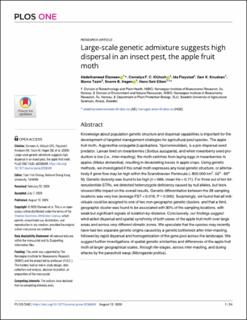| dc.description.abstract | Knowledge about population genetic structure and dispersal capabilities is important for the development of targeted management strategies for agricultural pest species. The apple fruit moth, Argyresthia conjugella (Lepidoptera, Yponomeutidae), is a pre-dispersal seed predator. Larvae feed on rowanberries (Sorbus aucuparia), and when rowanberry seed production is low (i.e., inter-masting), the moth switches from laying eggs in rowanberries to apples (Malus domestica), resulting in devastating losses in apple crops. Using genetic methods, we investigated if this small moth expresses any local genetic structure, or alternatively if gene flow may be high within the Scandinavian Peninsula (~850.000 km2, 55o - 69o N). Genetic diversity was found to be high (n = 669, mean He = 0.71). For three out of ten tetranucleotide STRs, we detected heterozygote deficiency caused by null alleles, but tests showed little impact on the overall results. Genetic differentiation between the 28 sampling locations was very low (average FST = 0.016, P < 0.000). Surprisingly, we found that all individuals could be assigned to one of two non-geographic genetic clusters, and that a third, geographic cluster was found to be associated with 30% of the sampling locations, with weak but significant signals of isolation-by-distance. Conclusively, our findings suggest wind-aided dispersal and spatial synchrony of both sexes of the apple fruit moth over large areas and across very different climatic zones. We speculate that the species may recently have had two separate genetic origins caused by a genetic bottleneck after inter-masting, followed by rapid dispersal and homogenization of the gene pool across the landscape. We suggest further investigations of spatial genetic similarities and differences of the apple fruit moth at larger geographical scales, through life-stages, across inter-masting, and during attacks by the parasitoid wasp (Microgaster politus). | en_US |

